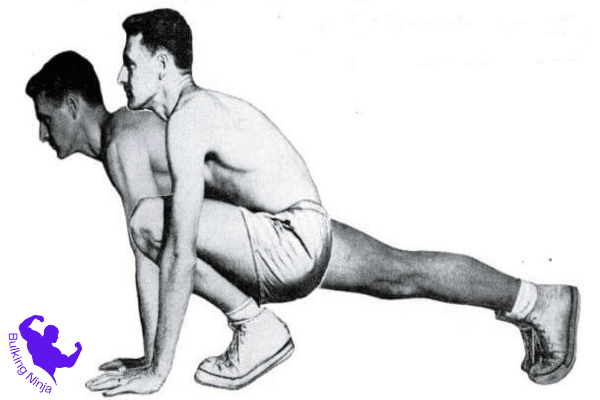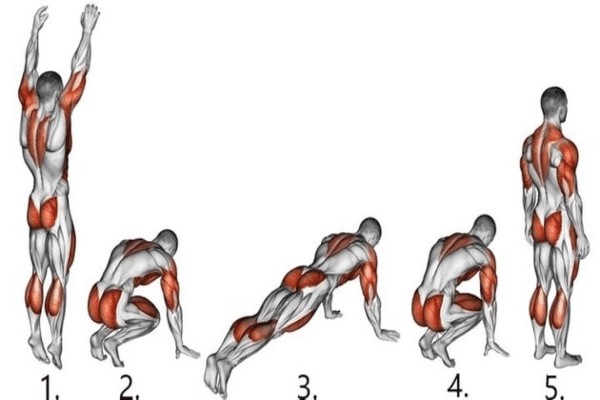Are you searching for a simple yet effective way to boost your strength and fitness levels? Look no further than one of the most straightforward exercises out there – burpees.
Often regarded as a full-body, high-intensity exercise, burpees have gained popularity in the fitness world for their ability to torch calories and improve cardiovascular endurance. But can these humble, bodyweight movements also help you build strength?
In this blog post, we’ll explore the potential of burpees as a strength-building exercise, and explain how can you gain strength with only burpees, more examining the mechanics behind the move and how you can incorporate them into your fitness routine to reap the benefits. Get ready to discover the surprising strength gains that can come from this deceptively simple exercise!
Table of Contents
Can you gain strength with only Burpees?

In the quest to determine whether one can truly gain strength with only burpees, it’s essential to recognize that burpees are a challenging exercise. These versatile movements engage major muscle groups throughout the body, making them an excellent choice for those seeking to boost their endurance and cardiovascular fitness.
The incorporation of a pushup within the burpee adds to its muscle-building potential, while the leap at the end elevates the exercise’s intensity. Moreover, the variations available for burpees allow individuals to tailor their workouts to their fitness levels, with easier options for beginners and more challenging choices for those seeking a rigorous workout.
Executed correctly and safely, burpees can undoubtedly contribute to building strength, burning calories, and improving overall cardio fitness. It’s a dynamic exercise that offers a comprehensive workout, making it a valuable addition to any fitness routine.
How to do Burpees workout?

Performing a burpee workout involves a sequence of movements that engage various muscle groups and elevate your heart rate. Here’s a step-by-step guide on how to do a basic burpee workout:
Starting Position
Begin in a standing position with your feet shoulder-width apart. Keep your arms at your sides.
Squat Down
Lower your body into a squat position by bending your knees and pushing your hips back. Place your hands on the floor in front of you, shoulder-width apart.
Kick Back
Kick your feet back behind you, landing in a plank position. Keep your body in a straight line from head to heels. Engage your core to maintain stability.
Push-Up (Optional)
Perform a push-up by lowering your chest to the ground while keeping your body in a straight line. You can skip this step if you’re a beginner or modify it by dropping to your knees for a modified push-up.
Return to Plank
Push back up to the plank position if you did a push-up.
Jump Forward:
Jump your feet back to the squat position. Explosively jump up from the squat, reaching your arms overhead.
Land and Repeat
Land softly on your feet in the starting position. Immediately go into the next repetition.
Repetition and Sets:
Perform the desired number of repetitions or time (e.g., 10-15 repetitions or 30 seconds). Rest for a short period (e.g., 15-30 seconds) between sets.
How to make it easier?
In the journey to discover if gaining strength with only burpees is possible, one must consider the variety of variations available. When faced with the initial challenge of a standard burpee, individuals can make adjustments to tailor the exercise to their current fitness level.
These adaptations, such as skipping the pushup and jump, can reduce the intensity while still targeting crucial muscle groups.
For those new to burpees, starting with a squat thrust allows for a less demanding initiation. Here, you begin in a squatting position, progressing to a pushup stance before returning to the starting stance without the leap. This gentler introduction ensures readiness and can help build up the necessary strength for more intense burpee variations in the future.
Moreover, if pushups are a concern, holding a plank position for a brief period substitutes for the pushup and aids in developing chest muscles and shoulder strength. Embracing these adjustments and variations transforms the challenging nature of burpees into a versatile tool for building strength and endurance.
How to make it more challenging?
To make burpees more challenging and increase their intensity, you can incorporate various modifications and additions to the basic burpee exercise. Here are some ways to elevate the difficulty of burpees:
- Add a Push-Up
Include a push-up at the bottom of the burpee. After kicking your legs back into a plank position, perform a full push-up before jumping your feet back to the squat position and leaping up. This adds an upper body strength component to the exercise.
- Jump Higher
Increase the height of your jump at the end of the burpee. Try to jump as high as you can with each repetition, engaging your leg muscles more and increasing the cardiovascular challenge.
- Add a Tuck Jump
Instead of a regular jump, perform a tuck jump at the end of the burpee. Bring your knees up towards your chest as you jump, challenging your core and leg muscles even further.
- Mountain Climber Burpees
After the push-up, do a set of mountain climbers by bringing your knees alternately towards your chest while in the push-up position. This adds an extra core and cardiovascular element.
- Burpee Pull-Ups
If you have access to a pull-up bar, combine burpees with pull-ups. After the jump, immediately perform a pull-up on the bar. This combination adds significant upper body and back strength challenges.
- Dumbbell Burpees
Hold dumbbells in each hand while performing burpees. This increases the resistance and requires more upper body and core strength to stabilize the weights.
- Single-Leg Burpees
Perform burpees using only one leg at a time. This variation significantly challenges your balance, leg strength, and coordination. - Elevated Push-Up
Place your hands on an elevated surface like a bench or step while doing the push-up in the burpee. This increases the range of motion and intensifies the challenge for your chest and shoulders.
- Burpee Box Jumps
Instead of a regular jump, jump onto a sturdy box or platform at the end of the burpee. This adds a plyometric element and requires greater explosive power from your legs.
- Burpee with Weighted Vest
Wear a weighted vest while doing burpees to increase resistance and overall difficulty.
Remember that as you make burpees more challenging, it’s crucial to maintain proper form to prevent injury. Start with modifications that suit your current fitness level and gradually progress to more advanced variations as you become more comfortable and stronger. Always prioritize safety and listen to your body’s signals during your workout.
Safety Tips about Burpees
Safety is essential when performing burpees, as they are a high-intensity exercise that can place stress on various muscle groups and joints. Here are some safety tips to keep in mind when doing burpees:
Warm-Up: Begin your workout with a proper warm-up. Perform dynamic stretches and movements to increase blood flow to your muscles and prepare them for the intensity of burpees.
Proper Form: Maintain correct form throughout the exercise to prevent injuries. Ensure your body is aligned during each phase of the burpee, from the squat to the jump. Keep your core engaged, and your back straight.
Land Softly: When jumping back to the squat position and jumping up, land softly to reduce impact on your joints, especially your knees and ankles. Bend your knees slightly upon landing to absorb shock.
Modify as Needed: If you’re a beginner or have any physical limitations or injuries, consider modifying the burpee. You can skip the push-up, reduce the number of repetitions, or perform a step-back instead of a jump-back.
Breathing: Focus on your breathing. Inhale as you squat down and exhale during the push-up and jump phases. Proper breathing can help you maintain energy and control during the exercise.
Maintain a Controlled Pace: Avoid rushing through burpees. Perform each repetition with control to reduce the risk of injury. Maintain a steady rhythm, and don’t sacrifice form for speed.
Use a Soft Surface: If possible, perform burpees on a softer surface like a fitness mat or a rubberized floor to reduce the impact on your joints.
Stay Hydrated: Ensure you’re well-hydrated before and during your workout. Dehydration can lead to muscle cramps and decreased performance.
Listen to Your Body: Pay attention to your body’s signals. If you experience pain, dizziness, or excessive fatigue, stop and rest. Overtraining can lead to injuries.
Proper Footwear: Wear appropriate athletic shoes with good cushioning and support, especially if you’re doing burpees on a hard surface.
Cool Down: After completing your burpee workout, cool down with static stretching to improve flexibility and reduce muscle soreness.
Which Muscles Are Used In Burpees workout?

Burpees are a compound, full-body exercise that engages multiple muscle groups. The primary muscles used in a burpee workout include:
Chest: The chest muscles (pectoralis major) are activated during the push-up phase of the burpee.
Shoulders: The deltoid muscles in the shoulders are involved in both the push-up and jump phases, as they help stabilize and move the arms.
Triceps: The triceps brachii muscles at the back of the upper arms are heavily engaged during the push-up portion of the burpee.
Core: The core muscles, including the rectus abdominis (front), obliques (sides), and transverse abdominis (deep core), are essential for maintaining stability throughout the entire movement.
Quadriceps: The quadriceps muscles in the front of the thighs are responsible for extending the knees during the jump and squat phases.
Hamstrings: The hamstrings at the back of the thighs are used when you bend at the hips and knees during the squat and jump.
Glutes: The gluteal muscles, particularly the gluteus maximus, are engaged when jumping and extending the hips.
Calves: The calf muscles (gastrocnemius and soleus) play a role in the explosive jump phase at the end of the burpee.
Back: The erector spinae muscles in the lower back help maintain an upright posture during the squat and push-up phases.
Hip Flexors: The hip flexor muscles, including the iliopsoas, are activated when lifting the legs to return to the squat position.
Forearms: The forearms and grip strength are involved as you place your hands on the ground and push up during the exercise.
Cardiovascular System: Burpees are excellent for cardiovascular fitness, as they elevate the heart rate and require efficient oxygen and nutrient delivery to working muscles.
By engaging these various muscle groups, burpees provide a comprehensive full-body workout that can help improve strength, endurance, and overall fitness.
What Are The Health Benefits Of Burpees?

Burpees offer a wide range of health benefits, making them a popular and effective exercise for improving overall fitness. Here are some of the key health benefits of burpees:
Full-Body Workout: Burpees engage multiple muscle groups simultaneously, providing a comprehensive full-body workout. This helps to build strength and endurance throughout the body.
Cardiovascular Fitness: Burpees are a high-intensity exercise that elevates the heart rate quickly. This cardiovascular demand can improve heart and lung health and increase overall cardiovascular fitness.
Burns Calories: Due to their intensity, burpees are an efficient calorie-burning exercise. They can help with weight management and fat loss when incorporated into a regular exercise routine.
Strengthens Muscles: Burpees target the chest, shoulders, arms, core, legs, and back, promoting muscle strength and tone. The exercise is particularly effective for developing functional strength.
Improves Explosive Power: The explosive jump at the end of each burpee enhances power and speed, which can be beneficial for sports and activities that require quick bursts of energy.
Enhances Coordination and Balance: Burpees involve various movements, including squats, push-ups, and jumps, which can improve coordination and balance as you transition between these actions.
Time-Efficient: Burpees are a time-efficient exercise that can be completed in a short amount of time, making them suitable for busy schedules.
Can Be Done Anywhere: You don’t need special equipment or a gym to perform burpees. They can be done virtually anywhere, making them a convenient choice for home workouts or when traveling.
Boosts Metabolism: High-intensity exercises like burpees can increase your metabolism, which may lead to improved energy expenditure and enhanced weight management.
Enhances Endurance: Regularly incorporating burpees into your fitness routine can help increase overall endurance and stamina, allowing you to perform other activities with greater ease.
Mental Toughness: Burpees can be mentally challenging due to their intensity. Performing them regularly can help build mental toughness and discipline.
Functional Fitness: Burpees mimic movements often required in daily life, such as bending, pushing, and jumping, making them valuable for improving functional fitness.
Variety and Progression: There are many variations of burpees, allowing for variety in workouts and opportunities for progression as your fitness level improves.
It’s important to note that while burpees offer numerous benefits, they can be physically demanding, especially for beginners or individuals with certain medical conditions. It’s advisable to start at a comfortable level, focus on proper form, and gradually increase intensity over time. If you have any concerns about incorporating burpees into your fitness routine, consult with a healthcare provider or fitness professional.
Frequently Asked Questions
Do Burpees increase strength?
Yes, burpees can increase strength in various muscle groups, including the lower and upper body, when performed correctly.
How many Burpees should I do for strength?
The number of burpees you should do for strength training depends on your fitness level and goals. It’s recommended to start with a manageable number and gradually increase as you progress. Beginners may start with 5-10 repetitions per set and aim for 2-3 sets, while more advanced individuals can do 15-20 or more repetitions per set.
It’s essential to focus on proper form and ensure that each repetition is performed correctly to maximize the benefits and minimize the risk of injury.
Are Burpees better than lifting weights?
The choice between burpees and weightlifting depends on your fitness goals. Burpees offer a full-body workout and cardiovascular benefits, while weightlifting allows targeted muscle growth and strength gains. Many people combine both for a balanced approach. Consider your goals and preferences, and consulting a fitness expert can help tailor your workout for maximum results. Consistency is key to achieving your fitness objectives.
What will 100 burpees a day do?
Doing 100 burpees a day offers various benefits: improved cardiovascular fitness, calorie burn for weight management, full-body workout, enhanced strength endurance, functional fitness, and mental toughness. Approach it gradually and with proper form, especially if you’re new to exercise or have medical conditions. Consulting a fitness professional is advisable for a safe and effective plan.
Is 20 burpees a minute good?
Performing 20 burpees in a minute is a challenging pace and can be considered good, as it indicates a high level of cardiovascular fitness and endurance. However, what’s considered “good” varies depending on your fitness level and goals. Beginners might find this pace very challenging, while experienced athletes may aim for even more. It’s essential to maintain proper form and listen to your body. Gradually increasing your burpee speed or repetitions per minute can be a goal to work towards as your fitness improves.
Can I do 50 burpees everyday?
Doing 50 burpees every day is possible, but consider your fitness level, recovery, and variation in your workouts. Ensure proper form and consult a fitness professional if needed. Overuse injuries are a concern, so monitor your body and be flexible with your routine.
Conclusion
In conclusion, burpees can indeed be a valuable tool for gaining strength, provided they are incorporated thoughtfully into a well-rounded fitness routine. These dynamic, full-body exercises engage numerous muscle groups and improve cardiovascular endurance.
However, whether burpees alone are sufficient for your strength-building goals depends on your individual fitness level, objectives, and preferences. For many, combining burpees with other strength-training exercises may yield the best results.
Ultimately, the key is consistency, proper form, and finding a fitness regimen that aligns with your unique needs and aspirations. So, whether you’re a burpee enthusiast or simply seeking an effective workout, remember that a balanced approach to fitness is often the path to achieving your desired strength gains.














